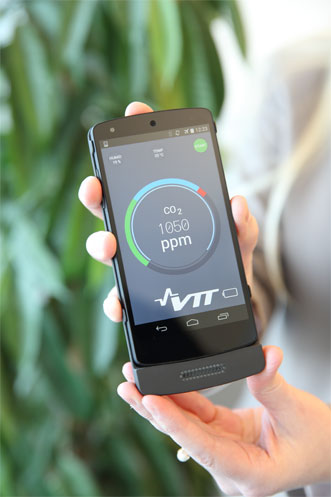Air and sleep quality can be gauged by an optical gas sensor that attaches to smartphones.
The VTT Technical Research Centre of Finland developed the device, which is based on Fabry-Perot interferometers and microelectromechanical systems (MEMS). It channels light through a sample and determines its composition based on the wavelength of light absorbed.
Carbon dioxide is identified based on its strong absorption at 4.2 μm. In addition, a corresponding sensor technology can be used to simultaneously differentiate between other gases or substances based on the spectrum of their absorption peaks at various IR wavelengths.

The optical gas sensor can be connected to mobile devices could enable development of new applications for monitoring air and sleep quality. Courtesy of the VTT Technical Research Centre of Finland.
Intended uses for the smartphone sensor include monitoring indoor carbon dioxide levels, as well as measuring sleep quality by using the device with health apps that gauge quantities of the gas in sleepers' exhalations.
Many sensor developers are interested in using smartphones to measure gas concentrations, according to VTT.
"This is probably due to the spread of the Internet of Things, which enables indirect observations of a range of environmental factors based on data gathered from single sensors or sensor networks," said research team leader Anna Rissanen. "Many day-to-day issues, such as precision and efficiency in the workplace, can depend on carbon dioxide levels and internal air quality."
VTT has developed Fabry-Perot interferomerers for various spectroscopy applications, such as hyperspectral cameras for nanosatellite- and drone-based environmental monitoring, the early detection of skin cancer, and fuel analysis for reducing emissions.
The VTT spinoff Spectral Engines OY of Helsinki already provides interferometer-based microspectrometers, while VTT Memsfab Ltd. manufactures MEMS chips, which can be mass produced for large-volume products.
For more information, visit www.vttresearch.com.